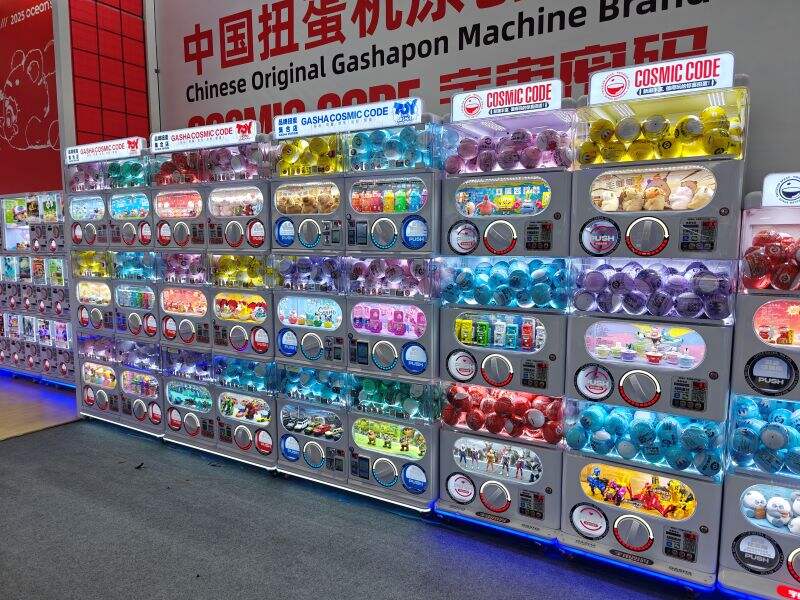Understanding Gashapon Machine Types and Capsule Capacity
What Is the Capsule Capacity of Gashapon Machines?
Gashapon machine capacity depends on capsule size and machine dimensions. Desktop models (12–16" tall) typically hold 50–100 standard 2" capsules, while commercial floor units (3–5' tall) store 200–500 capsules. High-capacity variants like the Mini Cosmic Code VIII use modular designs to maximize storage density, minimizing refill frequency in high-traffic locations.
Commercial vs. Desktop Gashapon Machines: Size and Storage Differences
Commercial espresso machines typically handle 3 to 4 times more volume than their desktop counterparts, built specifically for high traffic environments that need to process those bigger 75 to 100mm premium coffee capsules. The smaller 8 to 10 inch countertop models find their place in specialty cafes or home businesses with just 20 to 40 capsule slots available, though they definitely need refilling about two and a half times more frequently than commercial units. Some manufacturers have gotten really creative with space constraints lately. Take those flat panel machines measuring around 45 by 50 by 170 centimeters that somehow manage to squeeze in all necessary components while taking up minimal floor space in tight urban locations where every square meter counts.
How Machine Size Impacts Capsule Storage and Throughput
Larger cabinets enable two key capacity advantages:
- Vertical stacking systems that increase storage density by 40% compared to single-layer layouts
- Multi-compartment configurations that support multiple product lines
A 5' commercial machine can achieve 300% greater daily output than desktop models, thanks to automated inventory management and improved dispensing mechanics.
Capacity Considerations for Multi-Unit Gashapon Banks
Multi-unit clusters (4–12 machines) scale location capacity without proportional increases in floor space. Strategically grouping themed machines in entertainment hubs has been shown to boost per-customer spend by 18–22% versus standalone units. Modular banks allow operators to maintain capsule variety (6–8 product lines) while streamlining replenishment through centralized access points.
Key Factors in Gashapon Capacity Planning and Demand Forecasting

Demand Forecasting and Smart Inventory Management
Demand forecasting is essential in reducing overstock and ensuring efficient operations for gashapon machines. A 2023 vending industry report highlighted that 68% of operators using advanced analytics improved their stock management. Critical methods to enhance demand forecasting include:
- Thematic popularity scoring (e.g., anime collaborations vs. original designs)
- Foot traffic correlation models that align machine placement with venue visitor patterns
- Real-time inventory tracking via U.S. Gashapon Market segmentation studies which reduce replenishment delays by 29%
Utilizing Transaction Data for Enhanced Demand Predictions
Historical data shows that 35–50% of monthly revenue from commercial gashapon machines comes from repeat customers. By analyzing 12+ months of transaction data, operators can identify:
- Most popular items to ensure stock availability
- Items with slower turnover to adjust inventory
- Price elasticity trends, with $2–$4 capsules generating 62% of total sales
Seasonal Trends and Their Impact on Gashapon Demand
According to 2024 vending industry data, seasonal trends significantly affect gashapon demand. Major seasonal drivers include:
- Summer months driving 40% higher capsule turnover in coastal tourist areas than urban retail centers
- Holiday seasons boosting limited edition sales by 73%
- Regional event tie-ins, such as comic conventions, increasing nearby machine revenue by 210%
Aligning Capacity with Projected Demand in Vending Networks
A tiered capacity framework optimizes gashapon networks:
| Demand Tier | Machines per Location | Replenishment Frequency |
|---|---|---|
| High Demand | 8–12 units | Every 48 hours |
| Medium Demand | 4–7 units | Every 72 hours |
| Low Demand | 1–3 units | Weekly |
Step-by-Step Process for Effective Gashapon Capacity Planning
Assessing Current Gashapon Network Capacity
Conduct a comprehensive audit of your gashapon machine deployment. Track capsule consumption across locations using metrics such as:
- Average daily capsule output per machine
- Correlation with venue foot traffic
For effective capacity planning, identify underperformers by cross-referencing machine utilization with venue foot traffic. For example, a high-traffic mall unit may need weekly restocking, while a low-volume office lobby machine could be serviced monthly.
Identifying Capacity Gaps in Existing Deployments
Common capacity gaps arise when:
- Seasonal demand exceeds a machine’s 300-capsule limit
- Lower demand locations have underutilized machine capacity
A tiered prioritization system helps target improvements:
| Priority Level | Criteria | Action Example |
|---|---|---|
| Priority Level | Criteria | Action Example |
| Moderate | Operating at >50% stockout frequency | Upgrade to 500-capsule machines |
| Lower Priority | Operating at <50% stockout frequency | Optimize service intervals |
From Assessment to Action: A Practical Planning Framework
Implement a three-phase strategy over 90 days:
- Diagnostic Phase (Weeks 1–4): Map all machines using geolocation tagging and IoT-enabled inventory trackers
- Optimization Phase (Weeks 5–8): Optimize configurations and test new strategies in selected locations
- Scale Phase (Weeks 9–12): Deploy successful configurations network-wide and set up automated replenishment alerts
This structured approach increases capsule throughput by 30–40% without additional floor space. Centralized dashboards enable continuous monitoring, ensuring inventory stays aligned with demand.
Optimizing Space and Output in High-Demand Gashapon Locations
Harnessing the Power of Multi-Unit Gashapon Clusters
By grouping 4-12 gashapon machines together, operators save floor space while expanding product variety. This cluster approach reduces refilling needs by 18-25% compared to scattered individual machines. Additionally, it offers flexibility to experiment with different pricing and themes simultaneously, with real-world data showing a 20% increase in business in high-traffic retail spots when smaller machines are strategically placed.
Capacity Strategies for High-Traffic Retail and Entertainment Venues
High-traffic venues require compact yet efficient gashapon machines to meet customer demand while preserving floor space. Research suggests that smaller machines generate approximately 20% more business in urban retail locations when strategically positioned. Real-time data on stock levels helps ensure optimal inventory availability during peak hours, significantly reducing downtime.
Balancing Floor Space Constraints with High Demand
Customizable modular gashapon systems address space constraints by employing vertical stacking, which boosts storage by 40% without increasing floor space. Venues using spatial analytics to adjust machine numbers according to foot traffic can achieve greater efficiency and revenue generation.
Integrating Location Analytics into Equipment Capacity Planning
Implementing real-time occupancy sensors and foot traffic heatmaps enables venues to dynamically adapt device counts to match visitor patterns, achieving 27% higher capsule turnover. This data-driven strategy supports the allocation of 8-12 high-capacity machines (300+ capsules) at locations with high footfall, significantly enhancing profitability through efficient space utilization and timely replenishment.
FAQ Section
How does the size of a gashapon machine affect its capacity?
The size of a gashapon machine directly influences its capacity. Desktop models, which are typically 12-16 inches tall, can hold around 50–100 standard 2-inch capsules. In contrast, larger commercial floor units that are 3–5 feet tall can store up to 200–500 capsules thanks to their increased storage space and advanced storage designs.
What are the benefits of using multi-unit gashapon banks?
Multi-unit clusters allow venues to increase capacity without using more floor space, improve per-customer spending by offering diverse products in one location, and streamline replenishment due to centralized access points.
What factors should be considered in gashapon capacity planning?
Key considerations include thematic popularity, foot traffic correlations, and real-time IoT inventory tracking. Utilizing historical sales data and adjusting for seasonal trends also plays a crucial role in gashapon capacity planning and demand forecasting.
How can demand be forecasted effectively in gashapon locations?
Effective demand forecasting can be achieved through thematic popularity scoring, correlating foot traffic with machine placements, and employing real-time inventory tracking to reduce replenishment delays.
Table of Contents
- Understanding Gashapon Machine Types and Capsule Capacity
- Key Factors in Gashapon Capacity Planning and Demand Forecasting
- Aligning Capacity with Projected Demand in Vending Networks
- Step-by-Step Process for Effective Gashapon Capacity Planning
- Optimizing Space and Output in High-Demand Gashapon Locations
- FAQ Section

 EN
EN
 AR
AR DA
DA NL
NL FI
FI FR
FR DE
DE EL
EL HI
HI IT
IT JA
JA KO
KO NO
NO PL
PL PT
PT RU
RU ES
ES SV
SV TL
TL IW
IW ID
ID VI
VI HU
HU TH
TH TR
TR MS
MS GA
GA LO
LO MY
MY